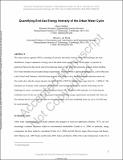| dc.contributor.author | Siddiqi, Afreen | |
| dc.contributor.author | De Weck, Olivier L | |
| dc.date.accessioned | 2018-04-27T17:31:28Z | |
| dc.date.available | 2018-04-27T17:31:28Z | |
| dc.date.issued | 2013-02 | |
| dc.date.submitted | 2011-12 | |
| dc.identifier.issn | 1076-0342 | |
| dc.identifier.issn | 1943-555X | |
| dc.identifier.uri | http://hdl.handle.net/1721.1/114997 | |
| dc.description.abstract | The water end-use segment (WES), consisting of activities that utilize water in homes and buildings, has been identified as a major component of energy use in the urban water supply system. In this paper, an analytical framework is presented which can be used at the planning stages of new urban developments to assess future building-level water demands and associated energy requirements. The framework is applied to Masdar City, a new urban area in the United Arab Emirates, which has been targeted in its design to be a future zero-carbon and zero-waste city. Results show that the energy intensity (in electric kWh) in WES for Masdar City may range from 2.6 to 4 kWh=m3. The dominant use of energy in this segment is attributed to water heating requirements, and the total energy use for obtaining hot water is estimated to range from approximately 20 to 50 million kWh annually. It is found that the residential sector in the city can have the greatest impact in affecting energy requirements associated with water use. For every unit reduction (in L=person=day) of indoor residential water use, it is estimated that up to 225 MWh may be saved annually. | en_US |
| dc.publisher | American Society of Civil Engineers (ASCE) | en_US |
| dc.relation.isversionof | http://dx.doi.org/10.1061/(ASCE)IS.1943-555X.0000153 | en_US |
| dc.rights | Creative Commons Attribution-Noncommercial-Share Alike | en_US |
| dc.rights.uri | http://creativecommons.org/licenses/by-nc-sa/4.0/ | en_US |
| dc.source | Other repository | en_US |
| dc.title | Quantifying End-Use Energy Intensity of the Urban Water Cycle | en_US |
| dc.type | Article | en_US |
| dc.identifier.citation | Siddiqi, Afreen, and Olivier L. de Weck. “Quantifying End-Use Energy Intensity of the Urban Water Cycle.” Journal of Infrastructure Systems 19, 4 (December 2013): 474–485 © 2013 American Society of Civil Engineers | en_US |
| dc.contributor.department | Massachusetts Institute of Technology. Department of Aeronautics and Astronautics | en_US |
| dc.contributor.department | Massachusetts Institute of Technology. Engineering Systems Division | en_US |
| dc.contributor.mitauthor | Siddiqi, Afreen | |
| dc.contributor.mitauthor | De Weck, Olivier L | |
| dc.relation.journal | Journal of Infrastructure Systems | en_US |
| dc.eprint.version | Author's final manuscript | en_US |
| dc.type.uri | http://purl.org/eprint/type/JournalArticle | en_US |
| eprint.status | http://purl.org/eprint/status/PeerReviewed | en_US |
| dc.date.updated | 2018-03-20T13:07:49Z | |
| dspace.orderedauthors | Siddiqi, Afreen; de Weck, Olivier L. | en_US |
| dspace.embargo.terms | N | en_US |
| dc.identifier.orcid | https://orcid.org/0000-0001-6677-383X | |
| mit.license | OPEN_ACCESS_POLICY | en_US |
